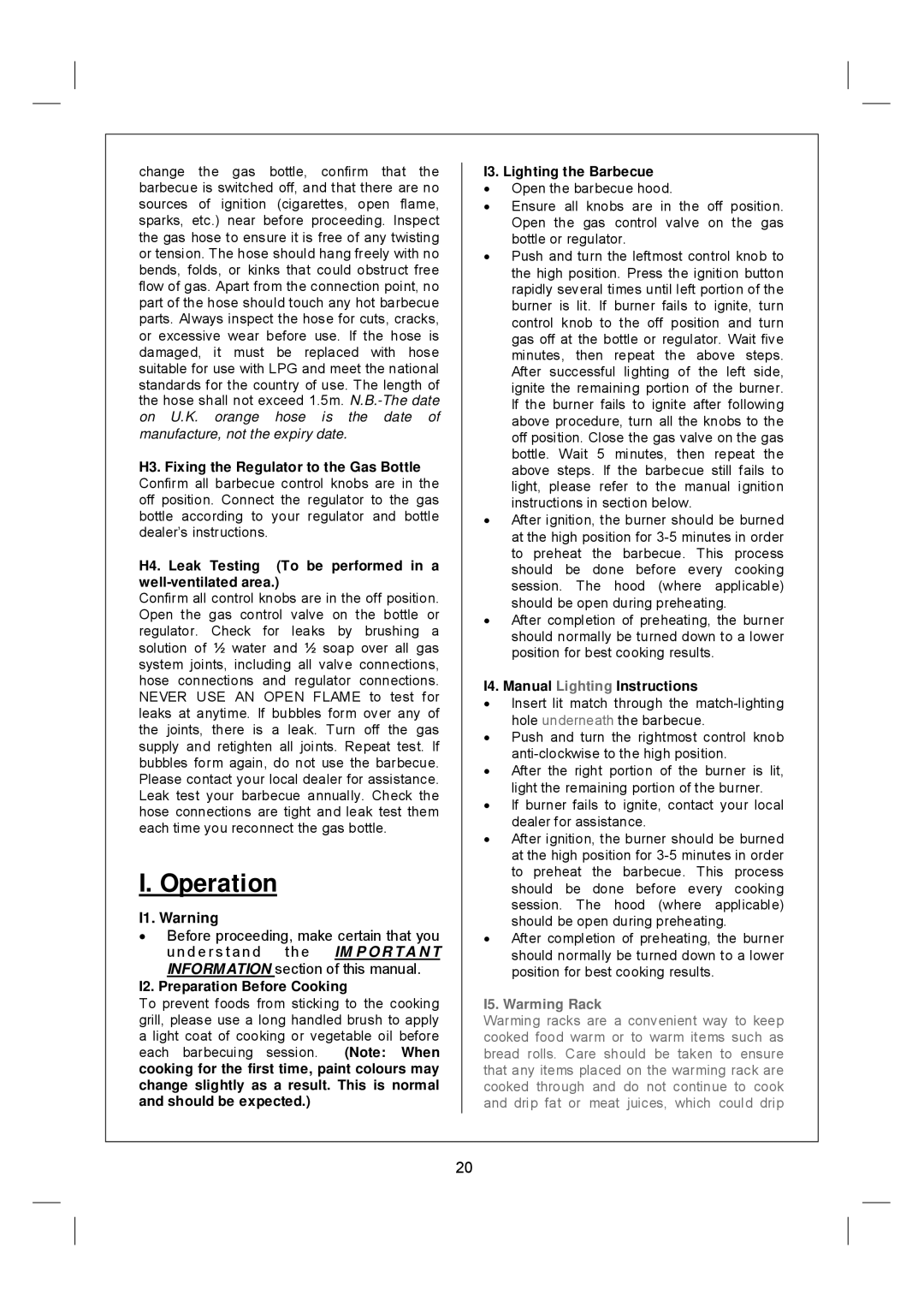
change the gas bottle, confirm that the barbecue is switched off, and that there are no sources of ignition (cigarettes, open flame, sparks, etc.) near before proceeding. Inspect the gas hose to ensure it is free of any twisting or tension. The hose should hang freely with no bends, folds, or kinks that could obstruct free flow of gas. Apart from the connection point, no part of the hose should touch any hot barbecue parts. Always inspect the hose for cuts, cracks, or excessive wear before use. If the hose is damaged, it must be replaced with hose suitable for use with LPG and meet the national standards for the country of use. The length of the hose shall not exceed 1.5m.
H3. Fixing the Regulator to the Gas Bottle Confirm all barbecue control knobs are in the off position. Connect the regulator to the gas bottle according to your regulator and bottle dealer’s instructions.
H4. Leak Testing (To be performed in a
Confirm all control knobs are in the off position. Open the gas control valve on the bottle or regulator. Check for leaks by brushing a solution of ½ water and ½ soap over all gas system joints, including all valve connections, hose connections and regulator connections. NEVER USE AN OPEN FLAME to test for leaks at anytime. If bubbles form over any of the joints, there is a leak. Turn off the gas supply and retighten all joints. Repeat test. If bubbles form again, do not use the barbecue. Please contact your local dealer for assistance. Leak test your barbecue annually. Check the hose connections are tight and leak test them each time you reconnect the gas bottle.
I. Operation
I1. Warning
•Before proceeding, make certain that you
und e r s t and t he IM P OR TA N T INFORMATION section of this manual.
I2. Preparation Before Cooking
To prevent foods from sticking to the cooking grill, please use a long handled brush to apply a light coat of cooking or vegetable oil before each barbecuing session. (Note: When cooking for the first time, paint colours may change slightly as a result. This is normal and should be expected.)
I3. Lighting the Barbecue
•Open the barbecue hood.
•Ensure all knobs are in the off position. Open the gas control valve on the gas bottle or regulator.
•Push and turn the leftmost control knob to the high position. Press the ignition button rapidly several times until left portion of the burner is lit. If burner fails to ignite, turn control knob to the off position and turn gas off at the bottle or regulator. Wait five minutes, then repeat the above steps. After successful lighting of the left side, ignite the remaining portion of the burner. If the burner fails to ignite after following above procedure, turn all the knobs to the off position. Close the gas valve on the gas bottle. Wait 5 minutes, then repeat the above steps. If the barbecue still fails to light, please refer to the manual ignition instructions in section below.
•After ignition, the burner should be burned at the high position for
•After completion of preheating, the burner should normally be turned down to a lower position for best cooking results.
I4. Manual Lighting Instructions
•Insert lit match through the
•Push and turn the rightmost control knob
•After the right portion of the burner is lit, light the remaining portion of the burner.
•If burner fails to ignite, contact your local dealer for assistance.
•After ignition, the burner should be burned at the high position for
•After completion of preheating, the burner should normally be turned down to a lower position for best cooking results.
I5. Warming Rack
Warming racks are a convenient way to keep cooked food warm or to warm items such as bread rolls. Care should be taken to ensure that any items placed on the warming rack are cooked through and do not continue to cook and drip fat or meat juices, which could drip
20
